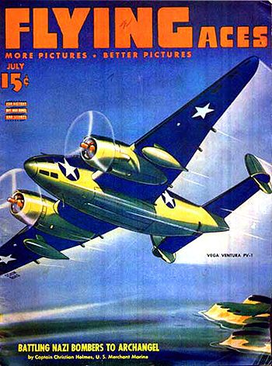Lieutenant Gerald Alfred Birks was a Canadian First World War fighter ace credited with twelve aerial victories while serving in the British Royal Flying Corps and Royal Air Force.

Max Ritter von Müller PlM, IC, MOMJ was a German World War I fighter ace credited with 36 victories. He was the highest scoring Bavarian pilot of the war.

Arthur Treloar Whealy DSC & Bar DFC was a Canadian First World War flying ace, officially credited with 27 victories.
William Frederick James Harvey DFC & Bar MC MBE was a British flying ace in World War I credited with twenty-six victories. He was the first recipient of the DFC & Bar and was also awarded the MC.

Flying Aces was a monthly American periodical of short stories about aviation, one of a number of so-called "flying pulp" magazines popular during the 1920s and 1930s. Like other pulp magazines, it was a collection of adventure stories, originally printed on coarse, pulpy paper but later moved to a slick format. The magazine was launched in October 1928 by Periodical House, Inc. It featured stories written and illustrated by known authors of the day, often set against the background of World War I. Later issues added non-fiction aviation articles, as well as articles and plans for model airplanes. The latter became more prominent, and eventually the magazine was renamed Flying Models, and catered exclusively to aeromodeling hobbyists.
Captain Thomas Frederic Williams MC was a Canadian First World War flying ace, officially credited with 14 victories.
Lieutenant James Cromwell Bush was a British World War I flying ace credited with six aerial victories.
Flight Lieutenant William Geoffrey Meggitt was a British World War I flying ace credited with six aerial victories.
Flight Lieutenant Norman Miers MacGregor was a British World War I flying ace credited with seven aerial victories, including over German ace Kurt Wolff.
Captain William Victor Trevor Rooper was a British World War I flying ace credited with eight aerial victories, before becoming Franz Xaver Danhuber's seventh victim.
Major George Lawrence Lloyd was a Rhodesian-born flying ace of the First World War, credited with eight aerial victories.
Captain Herbert George Hegarty was an Irish World War I flying ace credited with eight aerial victories.
Sergeant Frank Johnson was a World War I flying ace credited with 16 aerial victories. He flew as both an observer/gunner and as a pilot, and is the only enlisted man to receive a second award of the Distinguished Conduct Medal.
Captain Guy Borthwick Moore (1895–1918) was a Canadian World War I flying ace credited with ten aerial victories.
Group Captain Gilbert Ware Murlis Green, was a Royal Air Force career officer credited with eight aerial victories. He was a pioneer among fighter aces, and his victories were scored in a variety of theatres and flying environments. He was successful on both the Western Front, in Greece, and on his home soil. He also commanded two of the original night fighter squadrons.
Lieutenant Cecil Roy Richards was an Australian flying ace of World War I. He was credited with twelve aerial victories.

Captain Clive Franklyn Collett was a World War I flying ace from New Zealand credited with 11 aerial victories. He was the first British or Commonwealth military pilot to use a parachute, in a test. While serving as a test pilot, he crashed to his death in a captured German fighter.
Captain John Steel Ralston was a Scottish World War I war hero and flying ace. After winning a Military Cross in 1916 for lifesaving gallantry while serving in the infantry, he was credited with 12 official aerial victories as a fighter pilot before he was killed in action.
Air Commodore Roy Williamson Chappell began his military aviation career as a British World War I flying ace credited with 11 official aerial victories. He remained in service post-war, becoming an intelligence specialist on Japan and the Japanese military. He served through the end of World War II.
Oberleutnant Walter Ewers was a World War I flying ace credited with eight aerial victories.




